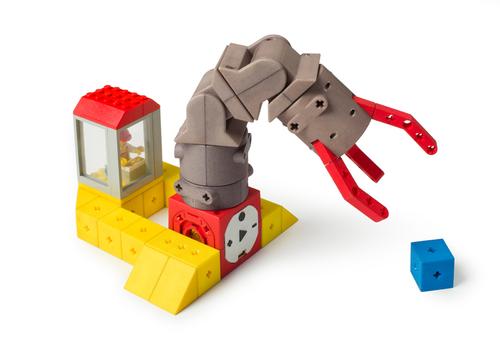TinkerBots Gives Tots a Robotic Building Kit
May 14, 2014

Two German engineers has created a toy set that let kids build robots from individual modules much in the same way they snap Legos together.
The TinkerBots set of kinetic modules and passive pieces is like Legos on steroids. In fact, Kinematics, the company that offers the building kit, says Lego bricks themselves can be used in building the robots.
Leonhard Oschutz and Christian Guder developed TinkerBots while studying product design at Bauhaus-University in Weimar, Germany. Following their graduation in 2011, the two engineers, along with Matthias Burger, formed Kinematics to market and sell their invention. Burger serves as CEO, Oschutz as chief creative officer, and Guder as CTO.
One integral TinkerBots module is the red "Power Brain," which Kinematics has patented. It provides the energy and contains an Arduino-compatible microcontroller, which lets the user control the robot. The module contains a two-hour battery, a USB port, a speaker, Bluetooth connectivity, and a control panel with record, play, and volume buttons.

Other pieces in the set include kinetic modules for moving the robot, such as the twister, the pivot, the motor, and the grabber. TinkerBots also includes small, passive building blocks so kids can customize their robots and add details; this is where Lego blocks can snap in, as well.
There are several methods for controlling the robot. A record-and-play mode lets people teach the robot to perform certain moves. To program the robot in this way, a child would take the robot in his or her hands, press the record button, and move it in the desired way. When the child hits the play button, the machine will move in the way it was taught.
There also is a TinkerBots app that lets the user control a robot via an Android-based smartphone. An iOS version of the app is coming soon.
The founders of TinkerBots are not the only inventors to design a Lego-like system for building robots. Modular Robotics already offers Cubelets, cube-shaped blocks that can be snapped together to form mini-robots that move in different ways autonomously. Last year, we told you how the company started a Kickstarter campaign for MOSS development kits that let people build custom robots using modular building blocks that snap together via magnets and allow for complex designs and movements, as well as remote control through a Bluetooth connection.
Burger told us about some key differences between MOSS and TinkerBots. He said that MOSS seems more of an education tool, but TinkerBots looks much more like a toy. Additionally, TinkerBots uses a pure mechanical connection to connect the blocks, while MOSS uses magnets. "The mechanical connection is more stable, less heavy, and more secure. "It also enables the transmission of power and data at the same time."
Children also have more creative freedom with TinkerBots in terms of how they can customize their robots and what type of robots they can build, he said. "You can build animals that walk, or even build your own quadrocopter/drone with TinkerBots." The set also provides more options for controlling robots.
Because of its modular, snap-in nature, children as young as 5 can use TinkerBots, according to the company.
The kit isn't meant just for children; adults also can make robots and work with their kids on their projects. A hobbyist robotics programmer can create more customized and sophisticated robots by programming C code for the Arduino microcontroller.
Related posts:
About the Author(s)
You May Also Like



